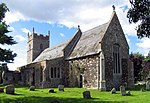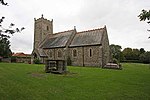Slevesholm Priory
Slevesholm Priory was a Cluniac priory in the civil parish of Methwold, Norfolk, England, that was dedicated to St. Mary and St. Giles. A cell of the Castle Acre Priory, Slevesholm Priory was either granted by William de Warenne, 5th Earl of Surrey between 1222-6 or established during the reign of king Stephen (1135–1154), and dissolved in 1537 during the dissolution of the monasteries. There are no extant remains of the priory; Historic England undertook field research in 1976 and remarked: "There are no physical remains of this [priory] at the formerly published site which is now under plough; farm workers questioned had no knowledge of early finds or foundations. [There is] impression of early quarrying [while] no recognisable pattern is evident and there is no surface trace of building material."Upon its dissolution it was granted to the Mundefords of Feltwell. Francis Blomefield in his An Essay Towards a Topographical History of the County of Norfolk (volume 2, 1805) writes the following succession of owners: "Francis, son of Osbert Mundeford, had livery of it in the 23d of Elizabeth [1581]. In 1600, Edmund Mundeford held it. After this we find it possessed by Captain Smith of Croxton, who conveyed it to Edward-Saunders Seabright; and Sir Thomas Seabright, Bart. died possessed of it in 1736."
Excerpt from the Wikipedia article Slevesholm Priory (License: CC BY-SA 3.0, Authors).Slevesholm Priory
Severalls Road, King's Lynn and West Norfolk
Geographical coordinates (GPS) Address Nearby Places Show on map
Geographical coordinates (GPS)
| Latitude | Longitude |
|---|---|
| N 52.5353451 ° | E 0.5086863 ° |
Address
Severalls Road
Severalls Road
IP26 4QU King's Lynn and West Norfolk
England, United Kingdom
Open on Google Maps







